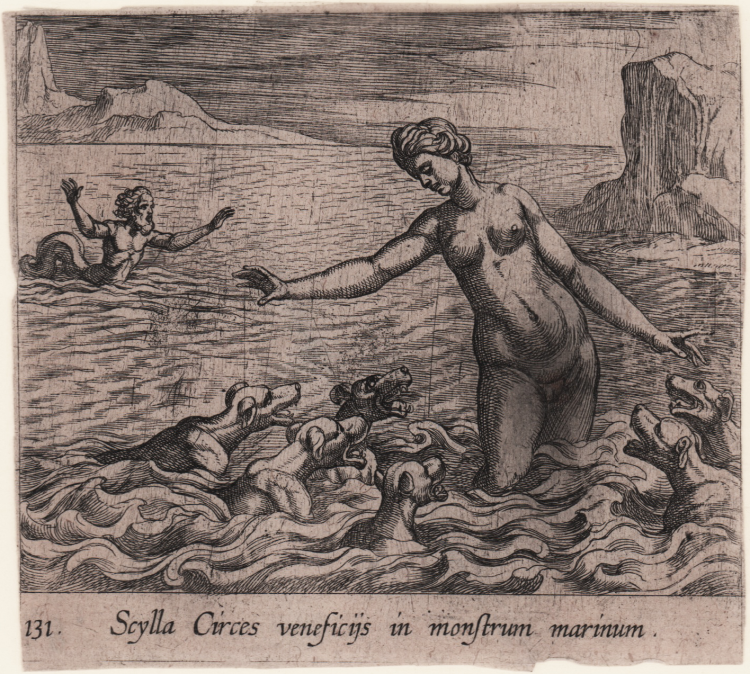



| Reference: | S35361 |
| Author | Antonio TEMPESTA |
| Year: | 1606 |
| Measures: | 118 x 105 mm |


| Reference: | S35361 |
| Author | Antonio TEMPESTA |
| Year: | 1606 |
| Measures: | 118 x 105 mm |
Scylla standing naked in the sea to right, with sea dogs surrounding her, and with Glaucus behind to left lamenting her transformation.
Etching, 1606, without signature. From the Metamorphoseon sive transformationum ovidianarum libri quindicem aeneis formis ab Antonio Tempesta work first published in Antwerp by Pieter de Jode in 1606.
A fine impression, printed on contemporary laid paper, very good condition.
A beautiful engraved print series illustrating Ovid's Metamorphoses, with engravings by the Italian mannerist artist and printmaker Antonio Tempesta (1555-1630). "These 150 copperplates, published not in Venice but in Antwerp in 1606 by Pieter de Jode [first edition] without an accompanying text, just one explanatory verse below each image, are one of the highest monuments that the graphic arts have elevated to the memory of Ovid" (Lafont).
Bibliografia
Bartsch, Le Peintre graveur (XVII.151.768); Cicognara 4749; Brunet 695; Graesse VI(2).49; Funck 399; Henkel-Illustrierte Augsbagen von Ovid's Metamorphosen in Bibl. Warburg Vorträge 1926, p. 60. A. Lafont, Shakespeare's erotic mythology and Ovidian renaissance culture (2013), pp. 25-26, 36.
Antonio TEMPESTA (Firenze 1555 – Roma 1630)
|
Italian painter, draughtsman and printmaker. Enrolled at the Accademia del Disegno in Florence on 8 December 1576, he was a pupil of Santi di Tito, then of Joannes Stradanus, with whom he worked under Giorgio Vasari on the interior decoration of the Palazzo Vecchio in Florence. He then went to Rome, where he again had links with artists from the Netherlands. He and Matthijs Bril were commissioned by Pope Gregory XIII to paint the Transfer of the Relics of St Gregory of Nazianzus (1572) and other religious scenes in the loggias on the third floor of the Vatican Palace. In Tempesta’s frescoes in the Palazzina Gambara at the Villa Lante in Bagnaia (1578–9), the hunting and fishing scenes, sweeping landscapes and urban backdrops again reveal the influence of Netherlandish art. From 1579 to 1583 Tempesta participated in the decoration of the Palazzo Farnese in Caprarola, notably of the Scala Regia. He is also known to have collaborated on the frescoes in the Villa d’Este at Tivoli.
|
Antonio TEMPESTA (Firenze 1555 – Roma 1630)
|
Italian painter, draughtsman and printmaker. Enrolled at the Accademia del Disegno in Florence on 8 December 1576, he was a pupil of Santi di Tito, then of Joannes Stradanus, with whom he worked under Giorgio Vasari on the interior decoration of the Palazzo Vecchio in Florence. He then went to Rome, where he again had links with artists from the Netherlands. He and Matthijs Bril were commissioned by Pope Gregory XIII to paint the Transfer of the Relics of St Gregory of Nazianzus (1572) and other religious scenes in the loggias on the third floor of the Vatican Palace. In Tempesta’s frescoes in the Palazzina Gambara at the Villa Lante in Bagnaia (1578–9), the hunting and fishing scenes, sweeping landscapes and urban backdrops again reveal the influence of Netherlandish art. From 1579 to 1583 Tempesta participated in the decoration of the Palazzo Farnese in Caprarola, notably of the Scala Regia. He is also known to have collaborated on the frescoes in the Villa d’Este at Tivoli.
|